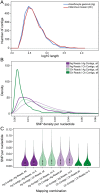Sticky Genomes: Using NGS Evidence to Test Hybrid Speciation Hypotheses
- PMID: 27187689
- PMCID: PMC4871368
- DOI: 10.1371/journal.pone.0154911
Sticky Genomes: Using NGS Evidence to Test Hybrid Speciation Hypotheses
Abstract
Hypotheses of hybrid origin are common. Here we use next generation sequencing to test a hybrid hypothesis for a non-model insect with a large genome. We compared a putative hybrid triploid stick insect species (Acanthoxyla geisovii) with its putative paternal diploid taxon (Clitarchus hookeri), a relationship that provides clear predictions for the relative genetic diversity within each genome. The parental taxon is expected to have comparatively low allelic diversity that is nested within the diversity of the hybrid daughter genome. The scale of genome sequencing required was conveniently achieved by extracting mRNA and sequencing cDNA to examine expressed allelic diversity. This allowed us to test hybrid-progenitor relationships among non-model organisms with large genomes and different ploidy levels. Examination of thousands of independent loci avoids potential problems produced by the silencing of parts of one or other of the parental genomes, a phenomenon sometimes associated with the process of stabilisation of a hybrid genome. Transcript assembles were assessed for evidence of paralogs and/or alternative splice variants before proceeding. Comparison of transcript assemblies was not an appropriate measure of genetic variability, but by mapping reads back to clusters derived from each species we determined levels of allelic diversity. We found greater cDNA sequence diversity among alleles in the putative hybrid species (Acanthoxyla geisovii) than the non-hybrid. The allelic diversity within the putative paternal species (Clitachus hookeri) nested within the hybrid-daughter genome, supports the current view of a hybrid-progenitor relationship for these stick insect species. Next generation sequencing technology provides opportunities for testing evolutionary hypotheses with non-model organisms, including, as here, genomes that are large due to polyploidy.
Conflict of interest statement
Figures




References
-
- Scali V, Passamonti M, Marescalchi O, Mantovani B. Linkage between sexual and asexual lineages: genome evolution in Bacillus stick insects. Biological Journal of the Linnean Society. 2003;79(1):137–50. 10.1046/j.1095-8312.2003.00172.x - DOI
-
- Radtkey RR, Donnellan SC, Fisher RN, Moritz C, Hanley KA, Case TJ. When Species Collide: The Origin and Spread of an Asexual Species of Gecko. Proceedings: Biological Sciences. 1995;259(1355):145–52.
Publication types
MeSH terms
Associated data
LinkOut - more resources
Full Text Sources
Other Literature Sources

